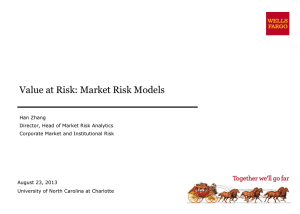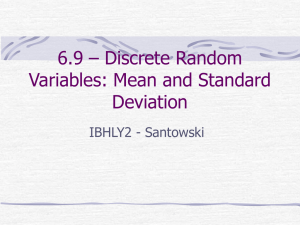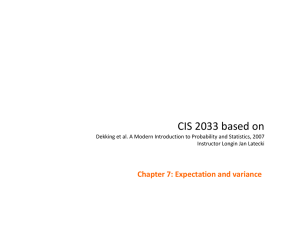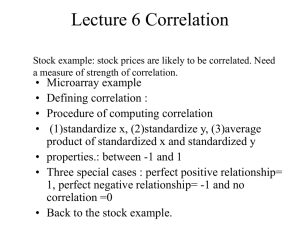Kalman Filtering.ppt
advertisement
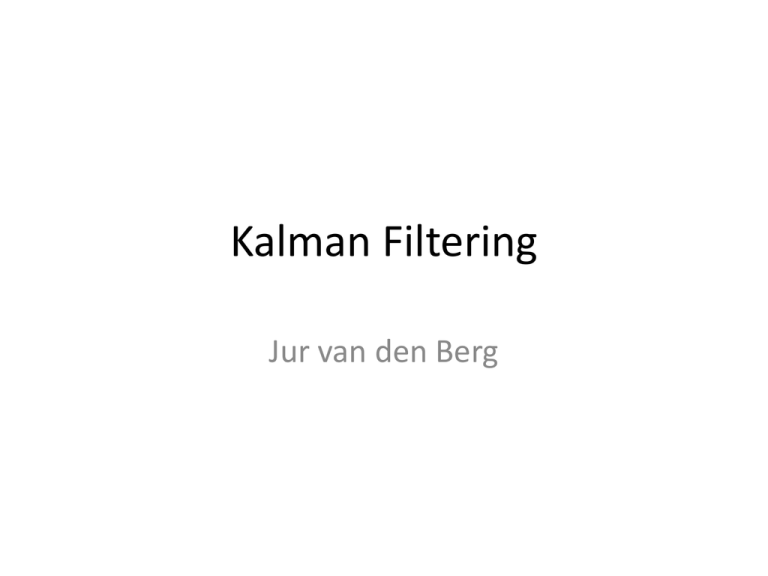
Kalman Filtering Jur van den Berg Kalman Filtering • (Optimal) estimation of the (hidden) state of a linear dynamic process of which we obtain noisy (partial) measurements • Example: radar tracking of an airplane. What is the state of an airplane given noisy radar measurements of the airplane’s position? Model • Discrete time steps, continuous state-space • (Hidden) state: xt , measurement: yt • Airplane example: xt x t xt , y t ~ xt x t • Position, speed and acceleration Dynamics and Observation model • Linear dynamics model describes relation between the state and the next state, and the observation: xt 1 Axt w t , w t ~ Wt N (0, Q) y t Cxt v t , v t ~ Vt N (0, R) • Airplane example (if process has time-step ): 1 A 0 1 0 0 1 2 2 , C 1 0 0 1 Normal distributions • Let X0 be a normal distribution of the initial state x0 • Then, every Xt is a normal distribution of hidden state xt. Recursive definition: X t 1 AXt Wt • And every Yt is a normal distribution of observation yt. Definition: Yt CX t Vt • Goal of filtering: compute conditional distribution X t | Y0 y 0 ,, Yt yt Normal distribution • Because Xt’s and Yt’s are normal distributions, X t | Y0 y0 ,, Yt yt is also a normal distribution • Normal distribution is fully specified by mean and covariance • We denote: X t |s X t | Y0 y 0 ,, Ys y s N E X t | Y0 y 0 ,, Ys y s , Var X t | Y0 y 0 ,, Ys y s N xˆ t|s , Pt|s Problem reduces to computing xt|t and Pt|t Recursive update of state • Kalman filtering algorithm: repeat… – Time update: from Xt|t, compute a priori distrubution Xt+1|t – Measurement update: from Xt+1|t (and given yt+1), compute a posteriori distribution Xt+1|t+1 X0 X1 X2 X3 X4 X5 … Y1 Y2 Y3 Y4 Y5 Time update • From Xt|t, compute a priori distribution Xt+1|t: X t 1|t AX t|t Wt N EAX t|t Wt , Var AX t|t Wt N A EX t|t EWt , A Var X t|t AT Var Wt N Axˆ t|t , APt|t AT Q • So, xˆ t 1|t Axˆ t|t Pt 1|t APt|t AT Q Measurement update • From Xt+1|t (and given yt+1), compute Xt+1|t+1. • 1. Compute a priori distribution of the observation Yt+1|t from Xt+1|t: Yt 1|t CX t 1|t Vt 1 N ECX t 1|t Vt 1 , Var CX t 1|t Vt 1 N C EX t 1|t EVt 1 , C Var X t 1|t C T Var Vt 1 N Cxˆ t 1|t , CPt 1|t C T R Measurement update (cont’d) • 2. Look at joint distribution of Xt+1|t and Yt+1|t: X t 1|t EX t 1|t Var X t 1|t CovX t 1|t , Yt 1|t , N EYt 1|t CovYt 1|t , X t 1|t Var Y t 1 | t xˆ t 1|t Pt 1|t Pt 1|t C T , N Cxˆ t 1|t CPt 1|t CPt 1|t C T R , Yt 1|t where CovYt 1 , X t 1|t CovCX t 1|t Vt 1 , X t 1|t C CovX t 1|t , X t 1|t CovVt 1 , X t 1|t C Var X t 1|t CPt 1|t Measurement update (cont’d) • Recall from undergrad that if 1 11 Z1 , Z 2 N , 2 21 12 22 then Z1 | Z2 z 2 N 1 12221 z 2 2 , 11 1222121 • 3. Compute Xt+1|t +1 = (Xt+1|t|Yt+1|t = yt+1): X t 1|t 1 X t 1|t | Yt 1|t y t 1 y Cxˆ , R CP N xˆ t 1|t Pt 1|t C CPt 1|t C R T T Pt 1|t Pt 1|t C T CPt 1|t C T 1 t 1 t 1|t 1 t 1|t Measurement update (cont’d): • Often written in terms of Kalman gain matrix: 1 K t 1 Pt 1|t C CPt 1|t C R xˆ t 1|t 1 xˆ t 1|t K t 1 y t 1 Cxˆ t 1|t Pt 1|t 1 Pt 1|t K t 1CPt 1|t T T Kalman filter summary • Model: xt 1 Axt wt , wt ~ Wt N (0, Q) yt Cxt v t , v t ~ Vt N (0, R) • Algorithm: repeat… – Time update: xˆ t 1|t Axˆ t|t Pt 1|t APt|t AT Q – Measurement update: 1 K t 1 Pt 1|t C CPt 1|t C R xˆ t 1|t 1 xˆ t 1|t K t 1 y t 1 Cxˆ t 1|t Pt 1|t 1 Pt 1|t K t 1CPt 1|t T T Initialization • Choose distribution of initial state by picking x0 and P0 • Start with measurement update given measurement y0 • Choice for Q and R (identity) – small Q: dynamics “trusted” more – small R: measurements “trusted” more Conclusion • Kalman filter can be used in real time • Use xt|t’s as optimal estimate of state at time t, and use Pt|t as a measure of uncertainty. Extensions • Dynamic process with known control input • Non-linear dynamic process • Kalman smoothing: compute optimal estimate of state xt given all data y1, …, yT, with T > t (not real-time). • Automatic parameter (Q and R) fitting using EM-algorithm




